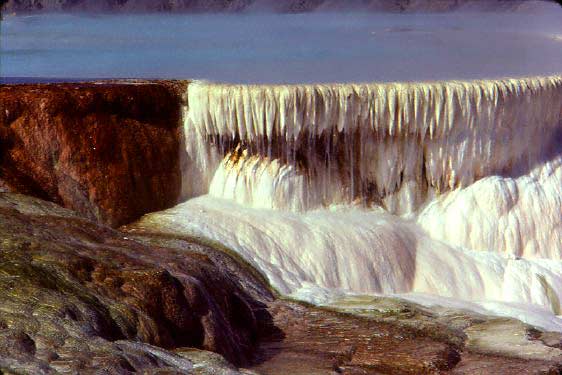
The Mammoth Hot Springs area differs from the Upper, Middle and Norris Geyser Basins in that there are no geysers in this thermal area. Water has a free path to the surface here; it flows freely from the springs. The water here is not hot enough to make a geyser. In fact, the water here flows from Norris Geyser Basin, 20 miles to the south, cooling along the way. Even at depths well below the surface, the hottest water found here is only 167° F, hot enough to scald but not hot enough to boil.
The hot springs at Mammoth flow over a series of travertine terraces. While traveling from the Norris area to Mammoth, the water has passed through limestone, which is readily dissolved in hot water. Thus the water emerging at Mammoth Hot Springs is saturated with calcium carbonate. As this water approaches the surface, the water cools and the pressure drops. Minerals precipitate out of solution as calcium carbonate deposits in the terraces.

Algae and bacteria live in the warm waters. It is thought that they are also responsible for for some of the mineral precipitation here. If the terrace rocks are thinly sliced and then viewed under a microscope, many very thin, lacy layers are seen. These are interpreted as levels in the photosynthetic activity of the bacteria during the day followed by periods of rest at night. Therefore the terraces seen here are the result of both geologic and biological processes.
The deposition of the terraces occurs very rapidly. The average rate found here is 8 inches a year. A U.S. Geological Services drill hole found 253.4 feet of travertine deposits. In this region, away from the central Yellowstone caldera, the sub-surface water temperature is much lower than in the other thermal basins.
See our map and guide reference section for trail maps and other useful information available from Maps.com.
All photographs are by Stephen E. Strom and are covered by copyright. © 1995